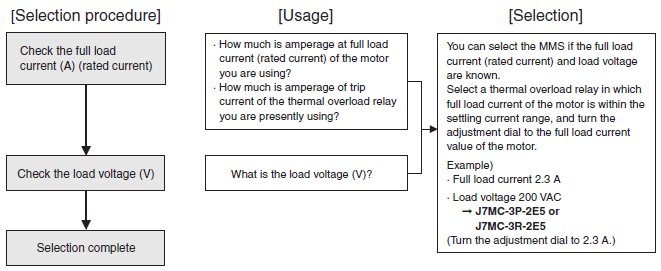Low Voltage Switching Gears
| Introduction | Features |
| Principles | Classifications |
| Engineering Data |
|
|
|
Troubleshooting |
What Is a Low Voltage Switching Gear?
Switching gears that perform starting/stopping and overload protection (burnout protection) in low voltage distribution and motor control.
What Is a Magnetic Contactor?
In general, a contactor by itself is called a magnetic contactor. Mainly used in stand-alone applications, such as electric circuit breaking and heater switching.
What Is a Thermal Overload Relay?
Used to protect a motor from burnout due to overload (overcurrent). The motor will burn out if a current exceeding the rated current flows in it for a certain period of time. Before that happens, the thermal overload relay activates (overload detected with a bimetallic strip) and cuts off the circuit.
What Is a Manual Motor Starter (MMS)?
This is a completely new type of motor protection circuit breaker. A single unit performs overload, phase failure and short circuit protection, and switching in the motor circuit. A single MMS unit functions as both a wiring circuit breaker and a thermal overload relay.
Magnetic Contactor or Thermal Overload Relay Selection Procedure

Manual Motor Starter (MMS) Selection Procedure

In Europe, to conform the safety standard IEC60204-1 for electrical equipment of machines, it is required to install overcurrent and overload protective device at power supply connection point on motor circuit.
Meanwhile, in Japan, JIS B9960-1 is regulated based on the above standard. Also, electrical equipment technical standard regulates that appropriate countermeasure for prevention of burnout accident is required, including installation of overcurrent circuit breaker at motor which exceeds 0.2 kW. Its trend is the similar as in Europe.
Manual Motor Starter (MMS) functions a wiring circuit breakers (short circuit protection) and thermal overload relay (overload, phase failure protection) with space saving.
Configuration and Operating Principle
Magnetic contactor
Magnetic contactor consist of contacts to open and close the electrical circuit for supplying electricity to the load such as electric motor, control coils for allowing contactor to open and close, and an electromagnet which made of iron core, and connection construction for transmitting the movement of the electromagnet to the contactor.
When the specified voltage is applied to the coil, the exciting current flows. This current generates magnetic flux in the iron core, then the iron core becomes a magnet. That is, the movable core is attracted toward the fixed core.
The movable contact support connected to this movable core by a pin incorporates a movable contact, moves by the movement of the movable core, contacts the fixed contact fixed to the frame, and closes the circuit.
When the voltage applied to the coil is turned OFF, the excitation of core is released and the movable core is pushed back to the right by back spring. At the same time, the movable core aparts from the movable contact and opens the circuit.

Configuration and Operating Principle
Thermal overload relay
The main components of the thermal overload relay are a heat element which consists of heater and bimetallic, an adjustment dial to set the operating current of thermal overload relay, and contacts to output the operating state by electrical signal.
The operating current to be detected by the thermal overload relay is set using the adjustment dial. According with that, the operating distance between the release lever and shifter is set. On the other hand, the current flows through the heater that composing the heat element. Then, the bimetal curves due to the heat energy generated by the heater, which changes the set operating distance. When the curvature of bimetal is greater than the operating distance, the reversal spring is activated, and the mechanical movement is transmitted to the contact mechanisms to open and close the contact.
Operating flow of thermal overload relay

Explanation of Operating Characteristics
• Below is the operating characteristics of standard model thermal overload relay (J7TC).
• The operating characteristics include cold start and hot start. The differences are described on Explanation of Terms.
• Explanation of Operating Characteristics
The vertical axis shows the operating time, and the horizontal axis shows the multiple of settling current. For example, when the current flows twice the settling current, the thermal overload relay trips in about 30 seconds to 2 minutes 20 seconds for cold start characteristics and 3 seconds to 60 seconds for hot start characteristics.

Explanation of the motor protection
If the motor is operating within the specified rated range, the internal winding insulator will keep own temperature rise within the rated range and the service life is no problem for actual use. However, if the motor will be overloaded or locked, the larger current than rated current flows which resulting in overheat, that may causes the insulation deterioration or burn. As a fundamental motor protection, the motor should be disconnected from the circuit before reaching such like this dangerous temperature.
For the protection by detecting of current, the allowable time for winding insulator to reach dangerous temperature against overload current is the operating characteristic of protective equipment. This time-current characteristic is called the thermal characteristic.
The characteristic of winding temperature from the ambient temperature state is published as the cold start characteristic and the characteristics from rated temperature rise state as the hot start characteristic.
The operating characteristics of protective equipment using current detection method must be lower than this thermal characteristics. However, since the thermal characteristics of electric motors differ depending on insulator type, protective structure, and number of poles, thermal overload relay, which is the most representative protective devices for current detection, in which the operating characteristics are specified by the regulation for standard electric motor.
Thermal overload relay satisfies these specifications and is capable of overload and rocking protection of standard motors operating constant load continuous operation.
